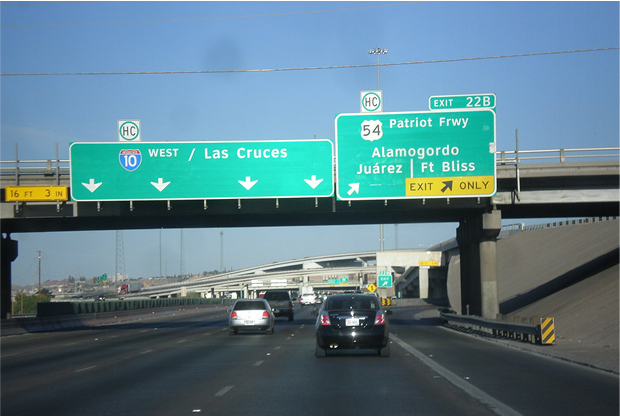El Paso ranks as the 18th most dangerous city in America for pedestrians. The Sun City recorded 95 traffic fatalities in 2023, representing a troubling 6.7% increase from the previous year.
Understanding these dangerous roads becomes crucial for both safety and legal protection. Texas’s comparative negligence laws mean that knowing road-specific hazards can significantly impact injury claims if accidents occur.
Interstate 10: El Paso’s Deadliest Highway Corridor
Interstate 10 stands as El Paso’s most dangerous road for serious accidents. TxDOT data reveals this highway recorded 2,977 crashes in a single year involving over 8,000 individuals.
Commercial traffic creates the primary hazard on I-10. More than 800,000 commercial trucks pass through El Paso annually, representing over 20% of all U.S.-Mexico land trade. These massive vehicles traveling alongside passenger cars create dangerous speed differentials.
Why I-10 Proves So Dangerous
Several factors make Interstate 10 particularly hazardous:
- Exit ramps separated by miles, creating emergency stop challenges
- Heavy commercial truck traffic mixing with passenger vehicles
- Ongoing construction zones that narrow traffic lanes
- Bridge maintenance on over 200 corridor structures
The eastern approaches present the greatest risks. Long stretches without exits mean drivers with vehicle problems face limited escape options. Meanwhile, construction zones funnel traffic into narrower lanes while maintenance work continues.
Joe Battle Boulevard: Texas’s Most Dangerous Intersection Zone
Joe Battle Boulevard contains three of the most dangerous intersections in all of Texas. These aren’t random accident locations but predictable danger zones with documented crash patterns.
The intersection of Joe Battle and Montwood recorded 187 crashes between 2012-2015 alone. Currently, Joe Battle and Edgemere holds the distinction as El Paso’s most dangerous intersection with 32 documented crashes in 2016.
Design Flaws Create Predictable Hazards
Specific infrastructure problems contribute to these accident rates:
- Complex merging lanes that confuse drivers
- Poorly designed turnarounds creating sudden stops
- Underpasses that limit visibility during peak hours
- Rapid development without corresponding road improvements
Montana Avenue’s intersection with Joe Battle creates another consistently dangerous hotspot. This location sees heavy north-south traffic converging with east-west movement along Montana Avenue, El Paso’s primary dividing line.
Transmountain Road: Mountain Terrain Creates Deadly Conditions
Transmountain Road presents unique dangers through the Franklin Mountains. Multiple mass casualty events involving commercial vehicles have occurred when trucks lose control on steep grades.
Recent accidents highlight the ongoing risks. A May 2025 incident left one dead and six injured when a semi-truck crashed. Additionally, an August 2024 rollover hospitalized eight adults and one minor in what officials labeled a “mass casualty event.”
Why Mountain Roads Prove Particularly Hazardous
Several factors combine to create dangerous conditions:
- Steep grades that stress vehicle braking systems
- High-speed traffic with limited escape routes
- Elevation changes that create visibility challenges
- Curves through mountain terrain limiting sight lines
TxDOT has announced plans for a second truck runaway ramp. However, current conditions require extreme caution from all drivers, particularly those operating commercial vehicles or towing trailers.
Weather Hazards: El Paso’s Unique Environmental Dangers
El Paso’s 2025 weather patterns have created what atmospheric scientists describe as “truly exceptional” driving conditions. The city experienced 28 days of dust storms in early 2025 alone.
These dust storms represent more dust activity than the entire period from 2000-2021 combined. Visibility can drop below one-quarter mile with little warning, creating life-threatening conditions on major highways.
Multiple Weather Threats Impact Road Safety
El Paso drivers face several environmental hazards:
- Dust storms (haboobs) that appear suddenly across transportation corridors
- Flash flooding that can close major routes like Paisano Drive and Doniphan Drive
- High winds exceeding 55 mph that threaten high-profile vehicles
- Extreme temperature variations affecting vehicle performance
From 2007-2017, an estimated 232 people died nationwide in dust storm-related traffic accidents. Recent regional impacts include a 38-vehicle pileup in Amarillo during March 2025.
Flash flooding poses serious seasonal threats. Just six inches of moving water can cause drivers to lose control. Texas law recognizes this severity by imposing fines up to $2,000 and 180 days in jail for driving around flood barriers.
Legal Implications: How Road Conditions Affect Injury Claims
Understanding El Paso’s dangerous road conditions becomes particularly important given Texas’s comparative negligence system. This legal framework operates under a 51% rule where injured parties cannot recover damages if they bear more than 50% fault.
Road-specific hazards can significantly affect fault allocation in injury cases. Experienced personal injury attorneys understand how environmental factors and infrastructure defects impact liability determinations.
Texas Insurance Laws and Road Hazards
Texas follows a traditional at-fault insurance system rather than no-fault coverage. The responsible party’s insurance bears primary liability for damages. However, minimum required coverage often proves inadequate for serious injuries.
Government liability for road design defects requires proving authorities had actual or constructive notice of hazardous conditions. El Paso’s Vision Zero initiative and documented crash data may serve as evidence that authorities recognize certain locations as dangerous.
Environmental Factors in Legal Cases
Courts consider whether drivers took appropriate precautions for known weather conditions. This makes it essential for El Paso drivers to:
- Monitor National Weather Service warnings regularly
- Adjust driving behavior for dust storms and high winds
- Avoid flooded roads regardless of apparent depth
- Maintain proper documentation of weather conditions during accidents
Safety Improvements: El Paso’s Vision Zero Initiative
El Paso has launched an ambitious Vision Zero initiative with $40 million in state funding. This program aims to eliminate traffic deaths and serious injuries by 2030 through systematic infrastructure improvements.
The initiative focuses on high-crash corridors like Joe Battle Boulevard and Interstate 10. Additionally, the program addresses pedestrian safety in areas where El Paso ranks among America’s most dangerous cities for walkers.
Current Safety Projects
Major safety improvements currently underway include:
- Enhanced intersection design at Joe Battle Boulevard hotspots
- Additional truck runaway ramps on Transmountain Road
- Improved signage and barriers for flood-prone areas
- Enhanced lighting at high-accident intersections
Furthermore, TxDOT has announced a $2.4 billion investment in El Paso road improvements. These projects will address both safety concerns and capacity issues created by rapid regional growth.
Protective Strategies for El Paso Drivers
Smart drivers can reduce their risk by understanding these documented hazards. Defensive driving becomes essential survival strategy in El Paso’s challenging urban environment.
Practical Safety Recommendations
Consider these protective measures:
- Avoid high-risk times: Rush hours on Joe Battle Boulevard and I-10
- Weather awareness: Monitor dust storm and flash flood warnings
- Route planning: Use alternate routes during adverse conditions
- Vehicle maintenance: Ensure brakes and tires handle mountain terrain
- Insurance coverage: Maintain adequate underinsured motorist protection
Additionally, consider avoiding Transmountain Road during high winds or when operating vehicles with high profiles. The combination of steep grades and wind exposure creates particularly dangerous conditions.
When Accidents Happen: Understanding Your Rights
Despite best safety efforts, accidents can still occur on El Paso’s dangerous roads. Understanding your legal rights becomes crucial for protecting your interests and securing appropriate compensation.
Texas’s comparative negligence system means that even partial fault doesn’t eliminate your right to compensation. However, it does reduce your recovery proportionally. This makes experienced legal representation particularly valuable.
Important Steps After Road Accidents
Take these immediate actions following accidents:
- Document weather and road conditions thoroughly
- Photograph infrastructure defects or hazards
- Obtain witness contact information
- Seek immediate medical attention for injuries
- Contact experienced personal injury counsel promptly
Remember that insurance companies often attempt to minimize payouts by claiming excessive comparative fault. Having knowledgeable legal representation helps ensure fair treatment under Texas law.
Call Lovett & Murray Law Firm today at (915) 757-9999 for your free consultation. We don’t get paid unless you win. Time limits apply under Texas law, so don’t wait to get the help you need after a dangerous road accident.

